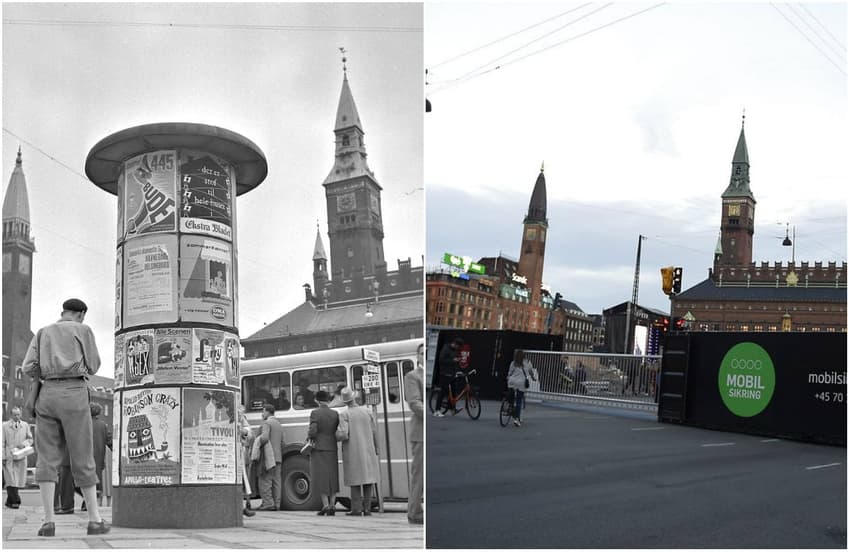10 photos of Denmark in the 1950s and 1960s – and the same spots today

We've scoured the archives to find 10 historical photos of Denmark taken at locations now found on Google Maps.
City Hall Square (Rådhuspladsen), Copenhagen, 1954

Photo: Erik Gleie / Ritzau Scanpix
Store Torv, Aarhus
We're probably going back to an earlier period than the 1950s with this undated photo, which shows a tram travelling towards the Skt. Clemens Kirke cathedral on Aarhus' central square Store Torv.

Photo: Ritzau Scanpix
Nyhavn 13, Copenhagen, 1966
What was once a clothes store that attracted queues of 1960s teenagers is now one of the many restaurants and cafes at tourist hotspot Nyhavn.

Photo: Lars Hansen/Ritzau Scanpix
Kongens Nytorv, Copenhagen, 1963

Photo: Ebbe Andersen / Ritzau Scanpix
Nyhavn, Copenhagen, 1969
A model poses for a photo at Nyhavn, now the setting for hundreds of selfies daily.

Photo: Erik Gleie / Ritzau Scanpix
Ferry to Sweden, 1964
People queue to take the ferry from Copenhagen to Malmö -- and enjoy duty-free shopping -- in 1964. The ferry was replaced by the Øresund Bridge in 2000.

Photo: Lars Hansen / Ritzau Scanpix
Roskilde Cathedral, 1968
A devastating 1968 fire destroyed the original Margrete Spire at Roskilde's medieval cathedral.

Photo: Lars Hansen / Ritzau Scanpix
Dronning Louises Bro, Copenhagen, 1964

Photo: Sven Gjørling / Ritzau Scanpix
Amagerbrogade, Copenhagen, 1964

Photo: Per Pejstrup / Ritzau Scanpix
First motorway, 1956
Denmark's first stretch of motorway was opened near Jægersborg in 1956. The Google image shows the area as it looks today.

Photo: Svend Gjørling / Ritzau Scanpix
READ ALSO: Ten historic pictures that show life in Denmark decades ago
Comments
See Also
City Hall Square (Rådhuspladsen), Copenhagen, 1954

Photo: Erik Gleie / Ritzau Scanpix
Store Torv, Aarhus
We're probably going back to an earlier period than the 1950s with this undated photo, which shows a tram travelling towards the Skt. Clemens Kirke cathedral on Aarhus' central square Store Torv.

Photo: Ritzau Scanpix
Nyhavn 13, Copenhagen, 1966
What was once a clothes store that attracted queues of 1960s teenagers is now one of the many restaurants and cafes at tourist hotspot Nyhavn.

Photo: Lars Hansen/Ritzau Scanpix
Kongens Nytorv, Copenhagen, 1963

Photo: Ebbe Andersen / Ritzau Scanpix
Nyhavn, Copenhagen, 1969
A model poses for a photo at Nyhavn, now the setting for hundreds of selfies daily.

Photo: Erik Gleie / Ritzau Scanpix
Ferry to Sweden, 1964
People queue to take the ferry from Copenhagen to Malmö -- and enjoy duty-free shopping -- in 1964. The ferry was replaced by the Øresund Bridge in 2000.

Photo: Lars Hansen / Ritzau Scanpix
Roskilde Cathedral, 1968
A devastating 1968 fire destroyed the original Margrete Spire at Roskilde's medieval cathedral.

Photo: Lars Hansen / Ritzau Scanpix
Dronning Louises Bro, Copenhagen, 1964

Photo: Sven Gjørling / Ritzau Scanpix
Amagerbrogade, Copenhagen, 1964

Photo: Per Pejstrup / Ritzau Scanpix
First motorway, 1956
Denmark's first stretch of motorway was opened near Jægersborg in 1956. The Google image shows the area as it looks today.

Photo: Svend Gjørling / Ritzau Scanpix
READ ALSO: Ten historic pictures that show life in Denmark decades ago
Join the conversation in our comments section below. Share your own views and experience and if you have a question or suggestion for our journalists then email us at [email protected].
Please keep comments civil, constructive and on topic – and make sure to read our terms of use before getting involved.
Please log in here to leave a comment.